|
Omega
Olympic Rattrapante
|
- Written by
Chuck
Maddox
 ,
with great assistance from Frank N. ,
with great assistance from Frank N. 
- on 13 December
2000, certain
rights reserved.
- Last Revised: 19
December 2000, 16:59 GMT
-

Recently, as part of a contest
held by the TimeZone Omega Forum, I won the right to choose
the next "Masthead" photo for the Omega Forum. This was not
a choice I felt I could take lightly. I am a collector of
chronographs. So the fact that a Chronograph would be chosen
was a given. That the photo would be of a watch from my
collection was also a near certainty. There was much
lobbying for various models of watches. There were even
requests for a Ladies watch to be chosen which would have
been a neat trick as I don't own a ladies watch of any sort!
I finally decided to use a couple of criteria:
- I wanted the watch to be
distinct from previous choices for the
Masthead
- I wanted the watch to be a
prime example of the horologic craft
- I wanted the watch to be
photogenic.
- I wanted the watch to
appeal to broad cross-section of potential
viewers.
- I quickly whittled down the
candidates to 4 specific models out of my many Omega's. I
eliminated all of the Speedmaster variants that I have
collected. I eliminated my quartz, and tuning fork model
watches. Sadly for a small but vocal group of lobbyists,
I eliminated my "Darth Vader" model Seamaster. I also
reluctantly eliminated my Bullhead Omega
Chronograph.
-
- The final four candidates
were: My Titanium Seamaster Professional Chronograph, a
watch I consider the best Sports chronograph available on
the market, period. My Flightmaster c.910 AM/PM, a
lesser known but very sophisticated counterpart to the
Omega Speedmaster Moonwatch, circa 1969. A front/back
collage of my 1967 Speedmaster Professional Pre-Moon with
conversion to Display Back. And lastly, a dark horse, my
Omega Olympic Rattrapante pocket chronograph.
-
- As you have read the title
of this article, you know which watch won out. The other
main contenders had very strong points, the SeMPC, it's
state of the art prowess, The Flightmaster it's handsome
looks and amazing vintage sophistication, the
Speedmaster... well how can you go wrong with a watch I
consider the watch of the 20th century, lastly the
Olympic. It has been a tough decision.
-
- The Omega Olympic is a very
special watch. Vintage, however, like many Omega watches
it is timeless in it's design. It is a watch that looks
as new and modern as the day it was made. It also is a
very sophisticated pocket watch, a chronograph that not
only allows one to time two contestants in the same race,
or to determine lap times, or in contests where
participants are separated by significant lengths of
time, many contestants in a contest.
-
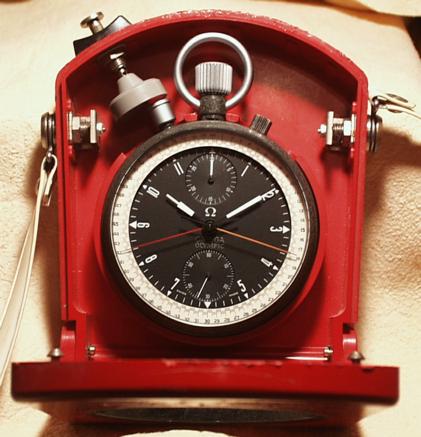 - Note:Click
on any picture with Blue border to go to an enlarged
version...
-
- Frank N. an Omega Forum
regular who hails from Denmark was able to find much
additional history of this timepiece and was able to
sumarize and email me a very interesting history behind
the development of this timepiece, I will be
interspersing his thoughts and comments (in
Italics) with mine throughout the rest of this
article...
- A fun fact
about the Olympic Rattrapante family is, that
it has been lost to history exactly when they
were designed (by Lemania). It was before
Omega took over Lemania in 1932, where these
watches were used extensively at the Olympic
games in Los Angeles.
-
- Your watch
belongs to the "Nuit Spatiale" ("Black
Space") series of Olympic and sporting event
timing equipment introduced by Omega in 1966
in anticipation of the 1968 Olympic games of
Mexico City. This series of sports timing
equipment was very extensive, covering every
facet of this dicipline, and was designed by
Lemania. These timers were all characterized
by a dual level black dial with an extra
outer rim for the second markers. This detail
in combination with the extra long second
hands and anti reflection coatings on the
crystal minimized the parallax error when
reading the time. The case has an Anthracite
coating, which effectively prevents slippage
when holding a timer with wet
hands.
|
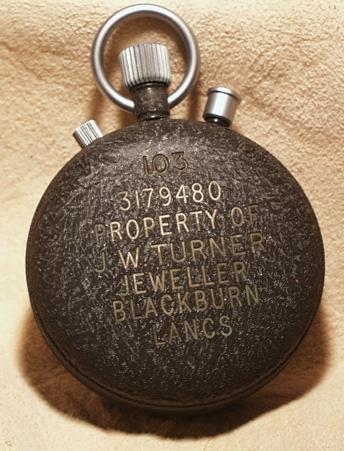 -
- You see one of the things
that set's apart the Olympic from many pocket
chronographs is it's protective plastic case. I believe
that this watch was manufactured for use with Automobile
Rallyes where participants are separated at the start of
a race over a course. This would allow the judge to set
the watch to 12 o'clock at the start of the race, and set
the chronograph running. The case is then shut and the
external button is pushed when a contestant passes a
checkpoint, the time is recorded and the button pressed
again so that the "split-second" hand can catch up with
the running chronograph hand.
-
- Your red
case is only part of the extras available for
these timers. With it one can carry the timer
in a strap over a shoulder. Another option
was a rather nice leather pouch made
specifically for this watch.
|
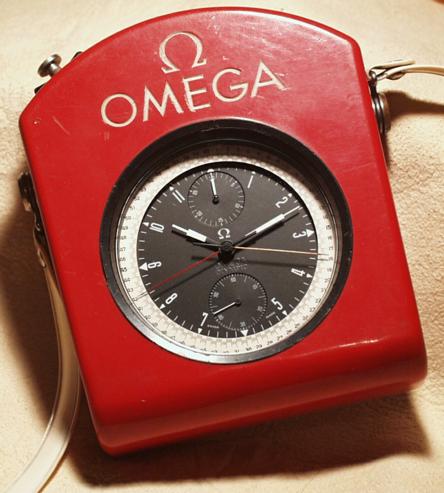
I was fortunate enough to
purchase my example from a reputable seller in the UK
near where the original owner lived... In the fabled
"Blackburn Lancashire" as sung by the Beatles. The
transaction was painless and the watch was
perfect. 
- During the
start of the international rally of the
United Kingdom in 1967 one of these watches
in its red case was ripped from the hands of
an official timekeeper by a Mini Cooper, and
was dragged by the side of the car, hanging
from the car door by it's strap! The hapless
piece of mechanics was hammered against the
side of the car for more than 10 kilometers,
before it was recovered and returned
undamaged(!) to its rightful owner, still in
perfect working order.
|
- In addition to Frank N.'s
wonderful contribution, Sergio Lorenzon who wrote from
Brazil, was able to point me out to a scan of the
movement of the Olympic and granted me permission to
include it here in this article:
-
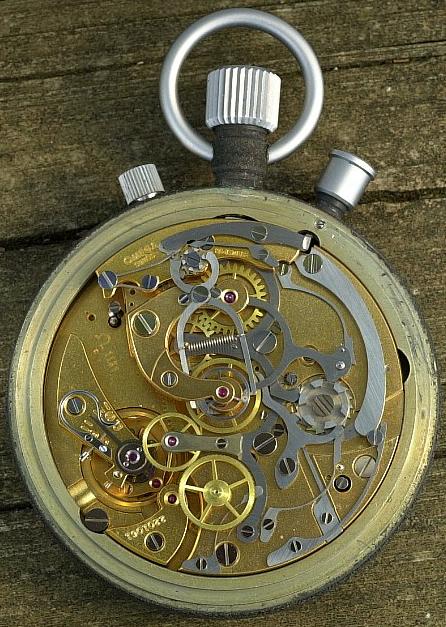
|
|
Contributed
by: Sergio Lorenzon
|
-
|
In 1969 the very
successful visual design of the Olympic
Rattrapante was, together with the Omega
Dynamic, awarded by the jury of the first
Biannual Swiss industrial design competition -
Dybs - against 250 competitors.
These watches
also exist in a solid gold version (with gold
and not black dial), and a few skeletonized
pieces even. The skeletons were hand made in
1974 by the retired head of assembly at Lemania,
Jules-Henri Meylan. Less than ten were made. I
have some rather nice photo's of one of the
skeletons, that I can try scanning if interested
(Copyright: Omega SA ;-). They are quite a piece
of work!
|
- Aside from what I've said,
I really know little about this watch, but would like to
know more. I feel that this watch highlights a
fascinating aspect of Omega's contribution to the
horologic craft which is sometimes forgotten in the
bright glow of the moon, Omega's prowess as an official
timer for sporting events, including well over a dozen
Olympic games.
-
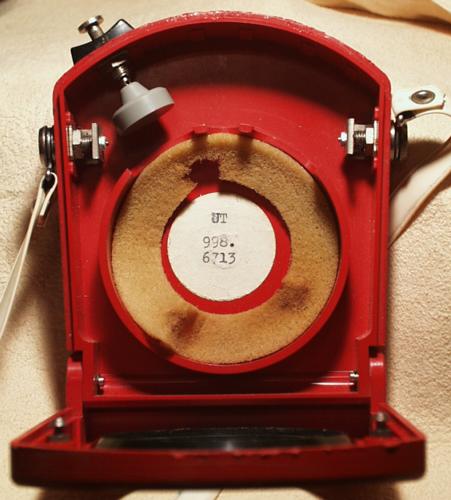 -
- Of course and as always, if
you have any information on this timepiece please feel
free to contact me, I'll add the information and give
credit.
-
- Thank you for your time and
interest!
-
- --
Chuck
Acknowlegements...
I would like to take
this opportunity to thank both Frank N. and Sergio Lorenzon
for the invaluable contributions to this article. This
article is much more informatative and useful because of
them and their actions. I'd also like to thank Bill Sohne
for turning me on to this wonderful piece of horological
history.
Statement
of rights retained and permissions granted...
Permission for
personal, educational or noncommercial use is granted. The
author retains all other rights not specifically mentioned
here...
For all other use please contact
the author.
If you have information about this watch please
contact
the author so
that I may update this article... Thanks!
Disclaimer: Opinions
are my own and knowing me should be taken with a grain or
two of salt...

|







